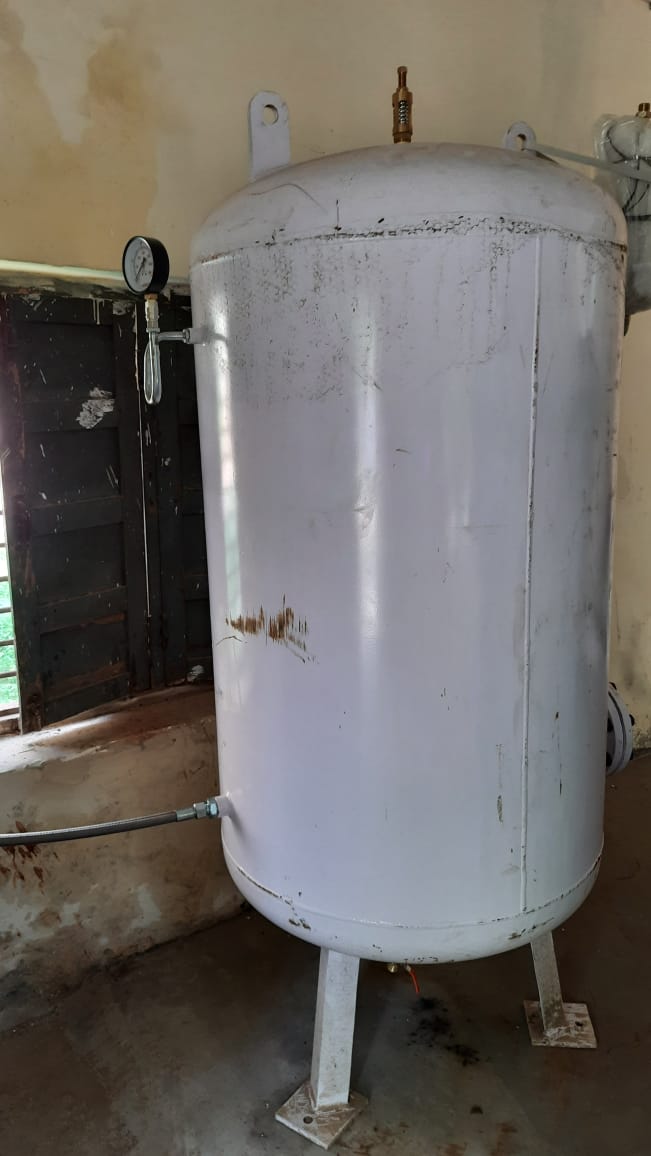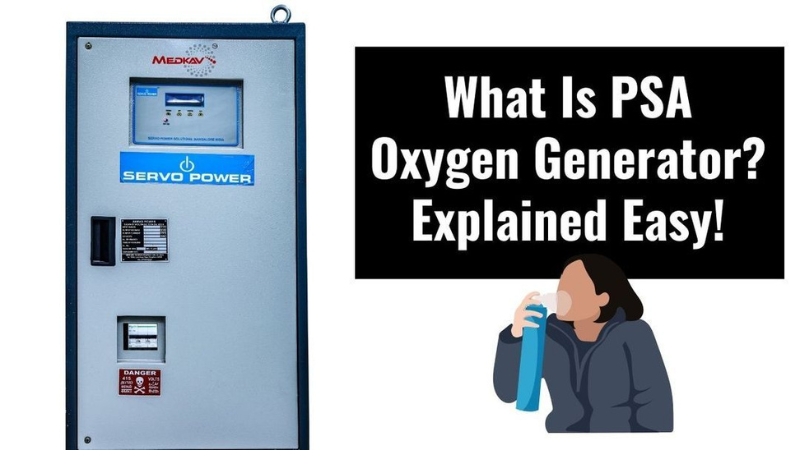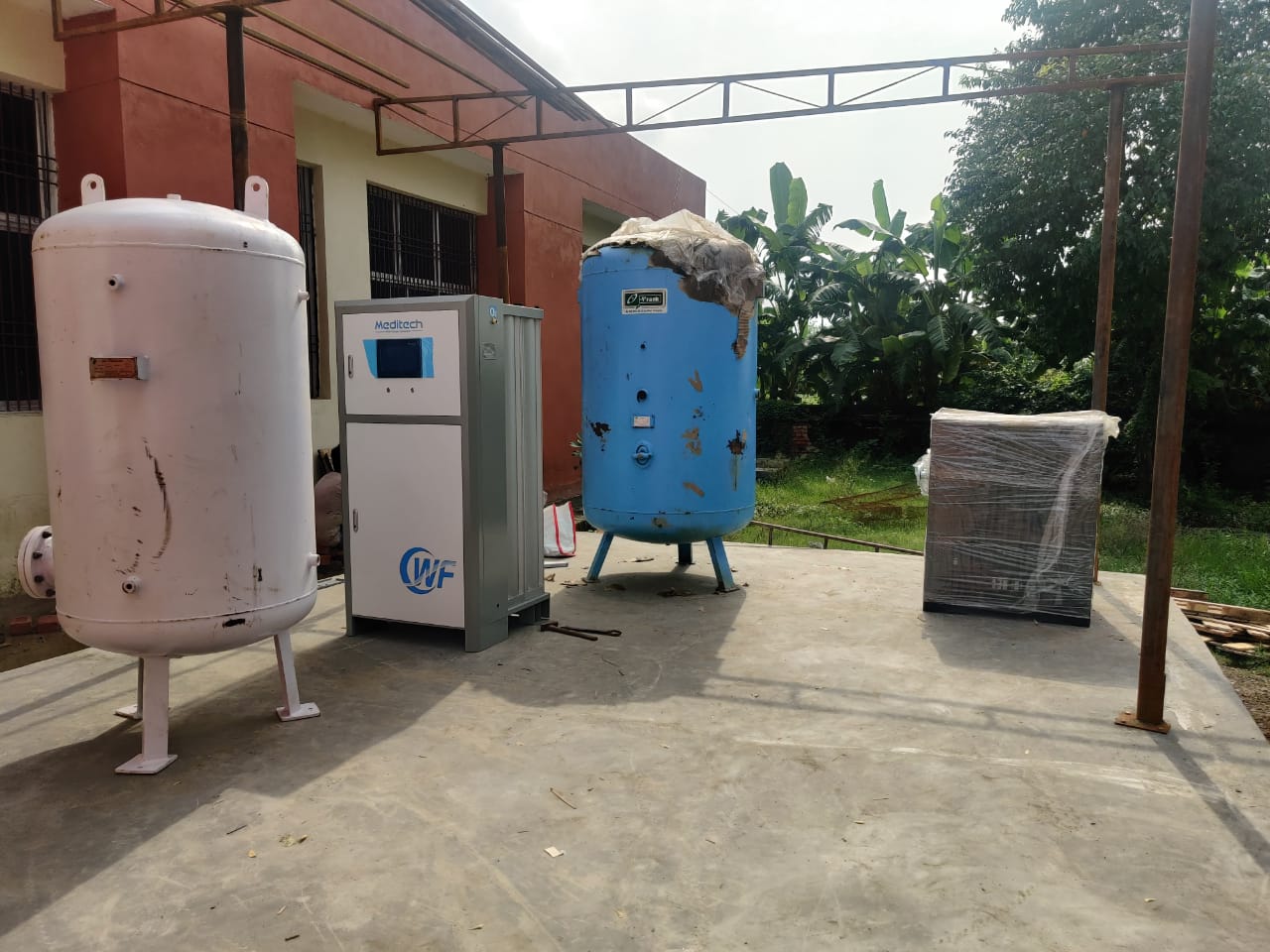Patients should only be given high-quality, medical-grade oxygen; it is a critical medicine that is required at all levels of the health-care system. Pressure swing adsorption (PSA) oxygen producing plants generate medical-grade oxygen.
With one key exception, the pressure swing adsorption process for a PSA oxygen generator is nearly identical to that of a nitrogen generator. Instead of the carbon present in a nitrogen PSA device, the adsorptive material inside its molecular sieve is constructed of zeolite.
Compressed air flowing through the oxygen generator will be split into its constituent gases during a typical operation. The zeolite molecular sieve will preferentially adsorb nitrogen that comes into contact with it, while enabling high purity oxygen gas to pass through to a product gas outlet.
The capacity of zeolite to release held nitrogen gas once the pressure within the generator is relieved is a unique trait that makes it perfect for an oxygen generator. This makes it simple to recycle the medium for a new oxygen production cycle.
The oxygen generator is based on a unique Pressure Swing Adsorption (PSA) technique that employs ambient air as a raw material.The oxygen content of ambient air is 21%, the nitrogen content is 78%, the argon content is 0.9 percent, and the rare gases content is 0.1 percent. The PSA process is a static separation of air gases using a molecular sieve designed to adsorb nitrogen under pressure, resulting in oxygen-enriched air with a concentration of 93 percent or more.
The oxygen generator is made up of two separation vessels filled with molecular sieve adsorbers (zeolites), a pneumatic system (valves, filters, pressure regulator...), and an oxygen tank that is all controlled by an automatic device.
A Medical Oxygen Generator Should Include The Following Features:
- 1. It has the potential to save your life.
- 2. A steady supply 7 days a week, 24 hours a day
- 3. Annual savings; return on investment (ROI) ranging from a few months to up to 18 months!
- 4. There is no need for transportation or refilling, unlike cylinders.
- 5. Unlike liquid oxygen tanks, bulk storage is not required. MedO assists you in conserving space, time, and money.
- 6. There are no signs of dependency or irregularity.
- 7. There is no chance of a price increase every year.
- 8. It is simple to set up (Roof, Basement, beside the hospital building)
- 9. A minimum of ten years of life, with the possibility of more if maintained according to protocol.
- 10. Customer care that is second to none, as well as a breakdown protection plan!
PSA Oxygen Generator Process
Filtered, degreased, and dried compressed air (78 percent nitrogen, 21% oxygen, 1% argon) is used, with the production pressure being automatically controlled.
Air travels through the molecular sieves, where nitrogen is absorbed by the zeolite, resulting in a 95 percent increase in oxygen content.
The oxygen produced by the molecular sieve is transferred through a multifunction block to the buffer tank. Nitrogen is driven back outdoors by a quiet exit.
One vessel's nitrogen desorption is aided by some of the oxygen created, while the other ensures oxygen generation (and vice versa).
Continuous oxygen flow is ensured via an automated and pneumatic vessel balance mechanism.
Pressure swing adsorption (PSA) oxygen generators use adsorbents to extract nitrogen gas from the air to create oxygen with a purity of 90% to 93 percent. Pressure vacuum swing adsorption (PVSA), vacuum pressure swing adsorption (VPSA), and vacuum swing adsorption are all terms used to describe the process (VSA). These generators remove nitrogen from the air through adsorption under pressure to efficiently create high-purity oxygen, taking advantage of the fact that the adsorption amount of the adsorbent (synthetic zeolite) under pressure is larger for nitrogen than oxygen.
They have been implemented at facilities that utilise huge amounts of oxygen because they can deliver a stable supply of oxygen at a lower cost than liquid oxygen.
MUST-READ ||
What Is PSA Oxygen Generator?
Medical PSA oxygen generators deliver life-saving oxygen to hospitals on five continents on a daily basis. The oxygen generator will meet your needs whether the country's criteria are 99 percent, 95 percent, or 90 percent. PSA oxygen production systems can provide a safe, efficient, low-cost alternative to frozen oxygen delivery in everything from small rural clinics to large metropolitan hospitals.
The process by which ambient air flows through an internal filtering system with a large enough total surface area to extract nitrogen (N2) from the air while concentrating the remaining oxygen (O2) to a predetermined purity is known as pressure swing adsorption (PSA). An air compressor, drier, filters, dual separation chambers, a reservoir, and controls are usually included.
PSA oxygen generator plant is a facility designed to concentrate oxygen from ambient air at scale, with output capacity ranging from 2 Nm3/hr to 200 Nm3/hr, depending on calculated oxygen demand. The oxygen produced by PSA plants can be routed straight from the oxygen tank to the wards, or it can be compressed further to fill cylinders using a supplemental booster compressor and a cylinder filling ramp/manifold.
All medical PSA oxygen generator facilities are oxygen sources capable of producing medical-grade oxygen on a large scale, 24 hours a day, seven days a week.
Oxygen generators are utilized in a range of business and industrial manufacturing applications today. These devices are critical in producing the required volumes of oxygen gas to power various operations.
In an oxygen generator that uses PSA technology, the ability of adsorbent zeolite material to separate a stream of compressed gas into its component gases is used. Pressure swing adsorption is a two-stage process that produces high-quality oxygen by combining simultaneous adsorption and desorption operations in two producing towers.
Adsorption
During the adsorption process of oxygen generation, an adsorptive tower filled with molecular zeolite pellets preferentially retains nitrogen while allowing oxygen to enter a collecting tank as product gas stream.
This selective adsorption will continue until the adsorptive tower reaches saturation, at which point the zeolite sieve will be unable to absorb any more nitrogen gas.
Desorption
This is essentially a reversal of the PSA oxygen generating
process
's adsorption innovation. Because it reaches saturation, the role of a tower in the adsorptive phase changes. The zeolite material is replenished by rapidly depressurizing the cylinder and releasing absorbed nitrogen gas into the atmosphere.
Disadvantages Of PSA Oxygen Generator
(1) It is inconvenient to handle compressed gas cylinders. Accidents involving sprains, bruising, or fractured bones can occur as a result of improper handling.
(2) There is a 3 percent loss of oxygen from cylinder-based devices as well.
(3) There is a risk of property damage, injury, or death, just as there is with liquid oxygen supply systems.Gas escapes from the cylinder, causing fires, explosions, chemical burns, poisoning, and cold burns.
The weight and portability of oxygen tanks are two of the foremost usually mentioned downsides. this implies that because of the device's weight, lifting the tank are difficult.Oxygen tanks have a selected amount of oxygen in them, and once they're empty, they have to be refilled or replaced with a spanking new tank.Because oxygen tanks must be replenished or changed regularly, their cheap initial cost adds up over time, making them dearer within the longer term.
PSA Oxygen Plant Working: Medkav Technologies
Oxygen cylinders are made using a relatively expensive industrial procedure. An oxygen cylinder must have a certain valve (regulator) and a flow metre in order to release oxygen in a controlled manner. It is incredibly wasteful to use oxygen from cylinders without a flow metre, and it is also quite dangerous without a regulator. Not all oxygen cylinders are the same; at least five different types are used in different countries. With a regulator, only one type of oxygen cylinder can be used.
Gather detailed information on the type of oxygen cylinder in use from the local oxygen supplier before ordering regulators. A hospital employee with technical expertise, such as an anaesthetist, a chest physician, or a fully qualified hospital technician, should verify this. Oxygen cylinders must be painted white according to an international standard for identification. Regrettably, the recommendation is usually ignored. Green medical oxygen cylinders are common in the United States, while black with white shoulders are common in Commonwealth countries. Industrial oxygen cylinders should be clearly labelled as well, however this is not often the case.
If you don't know what's in a cylinder, don't use it to provide gas to a patient. Getting oxygen to patients requires more than having oxygen cylinders on hand. You'll need a complete functional system in place, which includes not just the oxygen delivery apparatus, but also skilled operators and a maintenance, repair, and spare parts supply chain.
The following components must be included in a complete system for using oxygen in cylinders:
• Consistent supply of oxygen cylinders
• Transporting the cylinders to the hospital is required.
• Protocols to ensure that the hospital orders the correct amount of oxygen
Apparatus for transferring oxygen from the cylinder to the patient:
- A competent regulator
- A flow metre is a device that monitors the amount of water flowing through a pipe.
- Tubing for oxygen delivery
- A humidifier for the air
- A face-to-face oxygen tube for the patient
- An oxygen delivery catheter (or mask) for the patient's airway
• Someone who has received clinical training in delivering the correct amount of oxygen to persons who need it.
• A technician who inspects, maintains, and repairs the gadget as needed.
• A sufficient budget to ensure that oxygen is supplied at all times.
Before it flows to the buffer tank, the generator has an Online Digital Analyzer that measures the purity of the oxygen. The oxygen supply to the storage tank is cut off if purity goes below predetermined points, and an alert signal is displayed to signify a generator fault. When the purity of the gas drops below a certain level, the gas supply is transferred to the backup Oxygen source. The switchover panel does this for you automatically. To maintain continuous Oxygen supply, it closes the Auto-shut-off valve in the Oxygen supply line and actuates the reserve cylinder Oxygen supply valve.
Pressure Transmitter continuously monitors the pressure in the Oxygen Buffer tank. When the pressure in the Oxygen Buffer vessel drops below 3.5 Bar, an alert sounds. A drop in buffer vessel pressure also triggers the automatic activation of the backup supply system via the switchover panel.
Oxygen is consumed at 4-Barg pressure in most hospital applications, and this pressure is directly produced by our onsite oxygen generators. Market Oxygen cylinders can be linked as a back-up cylinder, or we can provide a Cylinders filling system that fills Oxygen cylinders up to 150-Bar pressure and then uses these Oxygen cylinders as backup cylinders. These filled Oxygen cylinders can also be used in isolated regions.
Medkav Technologies PSA Oxygen Generators
In collaboration with ASUMEDI AUSTRALIA (a MEDITECH CHINA affiliate) and KAVIA engineering, a top Bangalore firm.
ASUMEDI KAVIA disturbs, sells, services, and manufactures all types of oxygen generators and home oxygen concentrators.
ASUMEDI delivers home oxygen goods system products and large-scale medical solutions to hospitals, healthcare centres, veterinary hospitals, and companies such as aquaculture, and is now starting in India and the United States.
Because of their technical superiority, high reliability, and competitive performance-to-price ratio, our medical goods are well-known and popular in medical institutions all over the world.
In a novel type of oxygen generator with many modules connected in parallel, molecular sieves or Zeolites are employed. Each module is self-contained, so if one fails due to a filter failure, the others keep working. Flexible modules connected by a simple pipe and cable. The touch screen HMI can be connected to a computer or a smartphone, and it can display data from the plant's prior five years of operation. By utilising Mechanical Pre-tightening Technology, the newly designed Adsorber significantly reduces friction between molecular sieves, resulting in lower molecular sieve pulverisation and longer sieve life.Adsorbers manufactured of ALUMINIUM alloy with oxidation treatment have better corrosion resistance and are 30% lighter than carbon steel Adsorbers. Purity and Flow are completely computer and electronically controlled, with NO MANUAL SETTINGS accessible.



